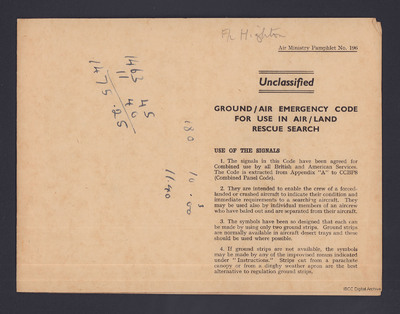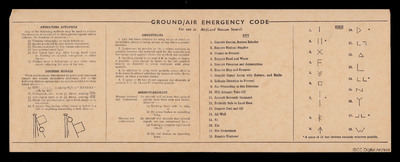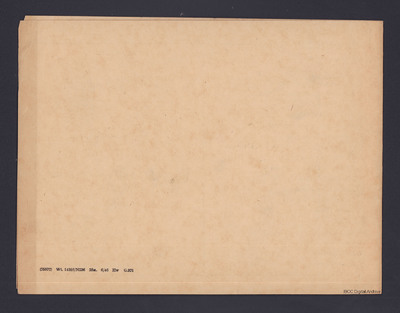Ground/Air Emergency Code for Use in Air/Land Rescue Search
Title
Ground/Air Emergency Code for Use in Air/Land Rescue Search
Description
Air Ministry Pamphlet 196 with distress signals to be used in emergency on the ground. A handwritten annotation states 'F/L Highton'.
Creator
Coverage
Language
Format
Two double sided printed sheets
Publisher
Rights
This content is available under a CC BY-NC 4.0 International license (Creative Commons Attribution-NonCommercial 4.0). It has been published ‘as is’ and may contain inaccuracies or culturally inappropriate references that do not necessarily reflect the official policy or position of the University of Lincoln or the International Bomber Command Centre. For more information, visit https://creativecommons.org/licenses/by-nc/4.0/ and https://ibccdigitalarchive.lincoln.ac.uk/omeka/legal.
Contributor
Identifier
MHightonG160645-180212-010001, MHightonG160645-180212-010002, MHightonG160645-180212-010003
Transcription
F/L Highton
[calculations]
[underlined] Air Ministry Pamphlet No. 196 [/underlined]
Unclassified
GROUND/AIR EMERGENCY CODE FOR USE IN AIR/LAND RESCUE SEARCH
USE OF THE SIGNALS
1. The signals in this Code have been agreed for Combined use by all British and American Services. The Code is extracted from Appendix “A” to CCBPS (Combined Panel Code).
2. They are intended to enable the crew of a forced landed or crashed aircraft to indicate their condition and immediate requirements to a searching aircraft. They may be used also by individual members of an aircrew who have baled out and are separated from their aircraft.
3. The symbols have been so designed that each can be made by using only two ground strips. Ground strips are normally available in aircraft desert trays and these should be used where possible.
4. If ground strips are not available, the symbols may be made by any of the improvised means indicated under “Instructions.” Strips cut from a parachute canopy or from a dinghy weather apron are the best alternative to regulation ground strips.
[page break]
GROUND/AIR EMERGENCY CODES
For use in Air/Land Rescue Search
ATTRACTING ATTENTION
Any of the following methods may be used to attract the attention of an aircraft to these ground signals and to indicate the location of survivors:-
(a) Wireless telegraphy or radio telephony.
(b) Smoke produced by any means whatsoever.
(c) Flames produced by any means whatsoever.
(d) Any pyrotechnical light.
(e) Any signal light (e.g. Aldis Lamp, hand torch or flashing on aircraft navigation or other lights).
(f) Flashes from a helicopter or any other shiny object reflecting the rays of the sun.
DISTRESS SIGNALS
When survivors are threatened by grave and imminent danger and require immediate assistance, any of the following distress signals may be used in addition to those listed above:-
(a) SOS [symbol] calls by W/T or “MAYDAY” calls by R/T
(b) Heliography, ect., as in (f) above, sending SOS.
(c) Any signal light as in (e) above, sending SOS.
(d) Single red pyrotechnical lights fired singly or in a succession.
(e) A square flag having either above or below it a ball or anything resembling a ball, thus:-
[flag diagrams]
INSTRUCTIONS
1. Lay out these symbols by using strips of fabric or parachutes, pieces of wood, stones, or any other available material.
2. Endeavour to provide as big a colour contrast as possible between the material used for the symbols and the background against which the symbols are exposed.
3. Symbols should be at least 8ft. in height or larger, if possible. Care should be taken to lay out symbols exactly as depicted to avoid confusion with other symbols.
4. In addition to using these symbols, every effort is to be made to attract attention by means of radio, flares, smoke, or other available means.
5. A space of 10 feet should separate the elements of symbols 2, 7, 10, 14, and 17 where possible.
ACKNOWLEDGEMENT
Message received and understood
An aircraft will indicate that ground signals have been seen and understood by:-
(a) Rocking from side to side,
Or
(b) By green flashes on signalling lamp.
Message not understood
An aircraft will indicate that ground signals are not understood by:-
(a) Making a complete right hand circuit
Or
(b) By red flashes on signalling lamp.
[underlined] KEY [/underlined]
1. Require Doctor, Serious Injuries
2. Require Medical Supplies
3. Unable to Proceed
4. Require Food and Water
5. Require Firearms and Ammunition
6. Require Map and Compass
7. Require Signal Lamp with Battery, and Radio
8. Indicate Direction to Proceed
9. Am Proceeding in this Direction
10. Will Attempt Take-Off
11. Aircraft Seriously Damaged
12. Probably Safe to Land Here
13. Require Fuel and Oil
14. All Well
15. No
16. Yes
17. Not Understood
18. Require Engineer
[underlined] CODE [/underlined]
[code symbols]
*A space of 10 feet between elements wherever possible
[calculations]
[underlined] Air Ministry Pamphlet No. 196 [/underlined]
Unclassified
GROUND/AIR EMERGENCY CODE FOR USE IN AIR/LAND RESCUE SEARCH
USE OF THE SIGNALS
1. The signals in this Code have been agreed for Combined use by all British and American Services. The Code is extracted from Appendix “A” to CCBPS (Combined Panel Code).
2. They are intended to enable the crew of a forced landed or crashed aircraft to indicate their condition and immediate requirements to a searching aircraft. They may be used also by individual members of an aircrew who have baled out and are separated from their aircraft.
3. The symbols have been so designed that each can be made by using only two ground strips. Ground strips are normally available in aircraft desert trays and these should be used where possible.
4. If ground strips are not available, the symbols may be made by any of the improvised means indicated under “Instructions.” Strips cut from a parachute canopy or from a dinghy weather apron are the best alternative to regulation ground strips.
[page break]
GROUND/AIR EMERGENCY CODES
For use in Air/Land Rescue Search
ATTRACTING ATTENTION
Any of the following methods may be used to attract the attention of an aircraft to these ground signals and to indicate the location of survivors:-
(a) Wireless telegraphy or radio telephony.
(b) Smoke produced by any means whatsoever.
(c) Flames produced by any means whatsoever.
(d) Any pyrotechnical light.
(e) Any signal light (e.g. Aldis Lamp, hand torch or flashing on aircraft navigation or other lights).
(f) Flashes from a helicopter or any other shiny object reflecting the rays of the sun.
DISTRESS SIGNALS
When survivors are threatened by grave and imminent danger and require immediate assistance, any of the following distress signals may be used in addition to those listed above:-
(a) SOS [symbol] calls by W/T or “MAYDAY” calls by R/T
(b) Heliography, ect., as in (f) above, sending SOS.
(c) Any signal light as in (e) above, sending SOS.
(d) Single red pyrotechnical lights fired singly or in a succession.
(e) A square flag having either above or below it a ball or anything resembling a ball, thus:-
[flag diagrams]
INSTRUCTIONS
1. Lay out these symbols by using strips of fabric or parachutes, pieces of wood, stones, or any other available material.
2. Endeavour to provide as big a colour contrast as possible between the material used for the symbols and the background against which the symbols are exposed.
3. Symbols should be at least 8ft. in height or larger, if possible. Care should be taken to lay out symbols exactly as depicted to avoid confusion with other symbols.
4. In addition to using these symbols, every effort is to be made to attract attention by means of radio, flares, smoke, or other available means.
5. A space of 10 feet should separate the elements of symbols 2, 7, 10, 14, and 17 where possible.
ACKNOWLEDGEMENT
Message received and understood
An aircraft will indicate that ground signals have been seen and understood by:-
(a) Rocking from side to side,
Or
(b) By green flashes on signalling lamp.
Message not understood
An aircraft will indicate that ground signals are not understood by:-
(a) Making a complete right hand circuit
Or
(b) By red flashes on signalling lamp.
[underlined] KEY [/underlined]
1. Require Doctor, Serious Injuries
2. Require Medical Supplies
3. Unable to Proceed
4. Require Food and Water
5. Require Firearms and Ammunition
6. Require Map and Compass
7. Require Signal Lamp with Battery, and Radio
8. Indicate Direction to Proceed
9. Am Proceeding in this Direction
10. Will Attempt Take-Off
11. Aircraft Seriously Damaged
12. Probably Safe to Land Here
13. Require Fuel and Oil
14. All Well
15. No
16. Yes
17. Not Understood
18. Require Engineer
[underlined] CODE [/underlined]
[code symbols]
*A space of 10 feet between elements wherever possible
Collection
Citation
Great Britain. Air Ministry, “Ground/Air Emergency Code for Use in Air/Land Rescue Search,” IBCC Digital Archive, accessed July 26, 2024, https://ibccdigitalarchive.lincoln.ac.uk/omeka/collections/document/41016.
Item Relations
This item has no relations.



